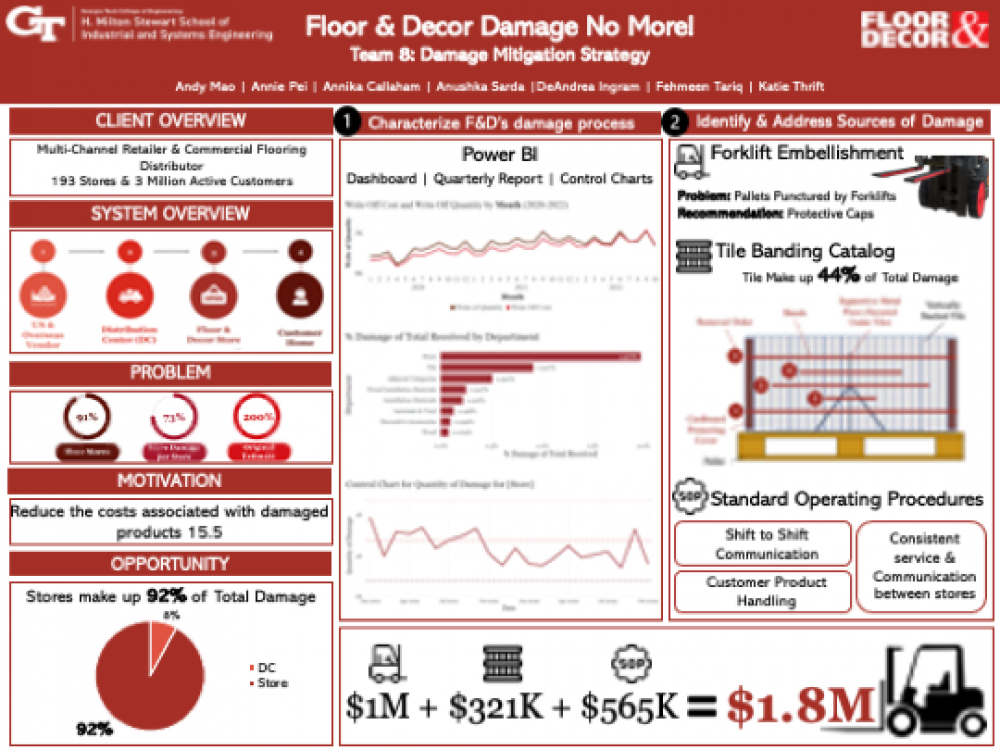Client Context
Floor & Decor currently operates 191 stores and 4 distribution centers across the US. Floor and Decor's supply chain plays a crucial role in its ability to minimize costs associated with damage. At a high level, Floor & Decor's supply chain system involves products being shipped from vendors around the world to the company's distribution centers in the US. From there, the products are transported to store warehouses, where they are prepared for shipment to individual customers or to retail locations for customer pickup. In this process, it is likely that products, especially fragile ones, get damaged and need to be written off. Floor & Decor incurs this cost, and it is known as the write-off cost.
Project Objective
The objective of this project is to reduce the cost associated with damaged products by (1) characterizing the overall damage process to learn more about high-risk products and (2) addressing specific areas where damage can be reduced.
Design Strategy
Based on interviews with store associates, we found that damage is most likely to occur when products are being moved from one location to another within the warehouse. This movement can be pinpointed to two areas in the warehouse pipeline, (1) the transportation of pallets from inbound trucks to the staging area by forklifts, and (2) the unpacking of products from pallets before they are displayed at the store. Forklifts often puncture products if they are misaligned with the pallet, which leads to damage. Furthermore, unpacking products from pallets causes high damage incidence in products that are notoriously fragile (i.e., tiles). We will focus our damage reduction efforts on the above two opportunities.
Deliverables
To characterize the damage process, the team created a PowerBI dashboard. This tool tells the client where damage is occurring the most, what is being damaged the most, and where these products are coming from. A forklift embellishment test plan will address the identified problem associated with forklifts puncturing products, and a tile banding catalog will address the identified problem associated with the unpacking of fragile products. Store visits also made apparent the discrepancies between different stores’ operations. Recommended changes to the existing standard operating procedures (SOPs) will address this problem.
Value and Impact
The costs associated with implementing the forklift embellishment test plan are minimal, consisting of the one-time costs of the protective pads and any additional labor required for maneuvering the thickened forks through the pallets. The benefits are calculated based on estimated lower bounds of percent damage reduction using 2022 damage data. If damage is reduced by only 5%, the benefits are over 1 million dollars more than the costs.
The costs of the new tile banding method can be broken down into four categories: the banding material, plywood, vendor labor, and banding machinery cost. The benefits are based on store associate labor savings and damage reduction percentages. When visiting stores, the team learned that store associates spend a minimum of ten hours flat stacking tiles at the beginning of each week during the day shift. Since data identifying the cause of damage at the store level (i.e. concealed damage, forklift damage, flat stacking damage, etc.) is not logged, we cannot directly estimate what percentage of damage would be reduced due to the new banding method. However, a store associate estimated that around 2-3 boxes per pallet are damaged due to flat stacking, which is about 21% of the total tile damage. Even if this estimate was cut in half, the benefits outweigh the costs by over 1.1x. If we believe the associate’s estimate, this ratio would be 1.7x.
The SOPs suggested are based on the practices of high-performing stores within a region or the benchmark stores. In theory, if all the stores of a region followed the best practices of their benchmark store, they should have a similar percent damage rate to that of the benchmark store. We have calculated the number of pallets damaged based on each store’s current damage percentage and the number of pallets damaged if the stores were to have a damage percentage reflective of the benchmark store Kennesaw, which is 2.5%. The estimated total reduction of damage for the three stores is 122 pallets saved for the three stores over one year. F&D has 193 stores so the value will be much greater if these SOPs are implemented in all their stores nationwide.


